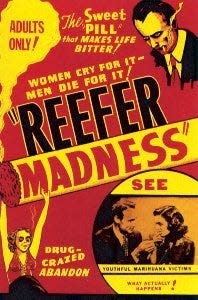Could smoking pot as a teen contribute to mental health problems in adulthood?

In the 1930s, a certain mythology surrounding marijuana began to sprout. A propaganda film began spreading that marijuana use would immediately send teenagers into a life of criminal activity and psychosis-like frenzies. The film was initially financed by a church group and marketed to parents as a cautionary tale.
Of course, this portrayal of cannabis’ danger was entirely fictionalized and wholly inaccurate; that film, “Reefer Madness,” has achieved cult status as an exploitation film and unintended satire.
But that isn’t to say cannabis has zero risks. Now, as cannabis products become more readily available alongside relaxing state laws across the country, Indiana University researchers are assessing how regular use of cannabis can impact teenagers’ mental health in adulthood.
Delta 8 THC: Relief from pain and anxiety or a legal way to get high?
Neuroscientists Ken Mackie and Hui-Chen Lu have received more than $2 million from the NIH's National Institute on Drug Abuse to research the impact of cannabis use during adolescence, with the intention to contribute to the development of new therapies and treatment options.
As part of their study, Lu and Mackie will use male and female mice with diverse genetic backgrounds to study the impact cannabis has on people.
Recent studies have indicated cannabis products, especially modified strains that have risen in popularity, can have a negative effect on brain development.
“The THC content of cannabis has increased dramatically in the last 20 to 25 years. That's concerning because a lot of the adverse effects seem to be due to THC,” Mackie said.
THC is the chemical compound in marijuana that causes the psychological effect of feeling high. While cannabis can be used as a relaxant in the moment, it can have the opposite effect later on.
“A lot of teenagers like that thrill and they think it has no impact when they grow up,” Lu said. “We want to know how it leads to long-term changes.”
The Centers for Disease Control and Prevention reports people who use marijuana are more likely to develop temporary psychosis, where they may have hallucinations or extreme bouts of paranoia. Long-term use, especially at a young age, also may contribute to developing mental disorders, such as schizophrenia, later in life.
“We are not trying to say marijuana is bad overall,” Lu said. “We just need to understand the risks and try to be aware and be careful.”
How cannabis, THC intrudes on the brain's growth spurts
“I like to emphasize that our brains are not identical,” Lu said.
The brain is elastic, Lu explained. Much like the body, it undergoes growth spurts. This explains why people can learn new things faster at a young age compared to when they are older. During stretches of time when the brain is rewiring, it is more vulnerable to environmental factors.
During adolescence, the brain is developing its prefrontal cortex.
“That part of the brain is really important for what's called executive functions, which are things that are involved in planning, working memory and more complex social interactions. During that period, the way the brain develops is by establishing specific synaptic connections,” Mackie said.
More:20% of Indiana's hemp crop was destroyed last year because it had too much THC
These connections are primarily established at a young age and are strengthened or eliminated over time. But elements of cannabis products, such as tetrahydrocannabinol (THC), can overwhelm these functions.
That being said, Mackie was quick to note marijuana use does not always result in brain dysfunction.
“A lot of these neurodevelopmental disorders — autism, schizophrenia — often seem to be caused by multiple small ‘hits.’ Any one of them alone is not enough to cause a problem, but when you cumulate all of them, then it causes a problem. Cannabis use seems to be one of those hits that can increase risk for panic disorder or schizophrenia,” Mackie said.
As detailed in a 2020 study, about 8% of eighth graders, 19% of 10th graders, and 22% of 12th graders reported vaping marijuana in the past year. This follows a two-fold increase in use by adolescents over the past two years.
Lu and Mackie also will be treading new territory by exploring the possible impact of cannabidiol (CBD), which is still widely unknown in the scientific community.
“You see it everywhere on the street. I see it even in my doctor's office and my yoga studio,” Lu said. “It has been advertised as a wonder drug without any harm.”
According to Mackie, CBD could have a positive effect as it has previously shown to lessen the negative impact of THC when taken together. However, further testing by Lu and Mackie intends to identify that potential impact.
One possible preventative solution is to follow Vermont and Connecticut's lead in imposing caps on THC concentration. Also, California recently had a proposed bill that would require large mental health warnings to be included on cannabis products.
But Mackie and Lu's research aims to be used for possible care options later on.
“We are not interested in just telling people how bad this is happening to them when they get to adulthood. We also help to understand at a mechanistic level so we could find treatment options for them,” Lu said. “Because you don't want to just give people bad news without treatment options.”
Contact Rachel Smith at rksmith@heraldt.com or @RachelSmithNews on Twitter.
This article originally appeared on The Herald-Times: Indiana University researchers study the effect of THC, CBD on teens
